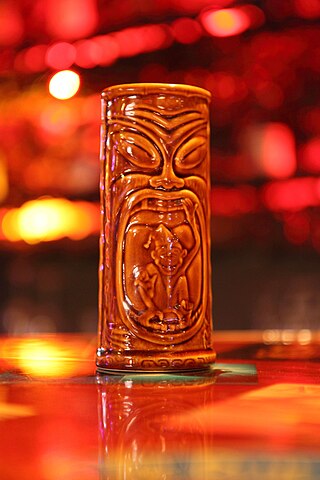
Hockey is a term used to denote a family of various types of both summer and winter team sports which originated on either an outdoor field, sheet of ice, or dry floor such as in a gymnasium. While these sports vary in specific rules, numbers of players, apparel, and playing surface, they share broad characteristics of two opposing teams using a stick to propel a ball or disk into a goal.

Tiki culture is an American-originated art, music, and entertainment movement inspired by Polynesian, Melanesian, and Micronesian cultures, and by Oceanian art. Influential cultures to Tiki culture include Australasia, Melanesia, Micronesia, Polynesia, the Caribbean Islands, and Hawaii. The name comes from Tiki, the Māori name for the first human, often represented in the form of hei-tiki, a pendant and important taonga. The hei-tiki was often appropriated by Europeans as a commercialised good luck charm, hence the name of Tiki culture. Despite spanning over 10,000 miles and including many different unrelated cultures, religions, and languages, Tiki aesthetic is considered by some to be amalgamated into one "fantasia of trans-Pacific cultures" and "colonial nostalgia". Because of this, and the simplistic view of the Pacific taken by the aesthetic, Tiki culture has often proved controversial.

The manipulation of the devil stick is a form of gyroscopic juggling or equilibristics, consisting of manipulating one stick between one or two other sticks held one in each hand. The baton is lifted, struck, or stroked by the two control sticks, stabilizing the baton through gyroscopic motion.
Stick or the stick may refer to:

A digging stick, sometimes called a yam stick, is a wooden implement used primarily by subsistence-based cultures to dig out underground food such as roots and tubers, tilling the soil, or burrowing animals and anthills. It is a term used in archaeology and anthropology to describe similar implements, which usually consists of little more than a sturdy stick which has been shaped or sharpened and sometimes hardened by being placed temporarily in a fire.

Floor hockey is a broad term for several indoor floor game codes which involve two teams using a stick and type of ball or disk. Disks are either open or closed but both designs are usually referred to as "pucks". These games are played either on foot or with wheeled skates. Variants typically reflect the style of ice hockey, field hockey, bandy or some other combination of sport. Games are commonly known by various names including cosom hockey, ball hockey, floorball, or simply floor hockey.

A cocktail umbrella or paper parasol is a small umbrella made from paper, paperboard, and a toothpick. They are frequently associated with tropical drinks and Tiki bars and used as a garnish decoration. They are also used in desserts or other foods and beverages.

A tiki mug is a large ceramic cocktail drinking vessel that originated in tiki bars and tropical-themed restaurants. The term "tiki mug" is a blanket term for the sculptural drinkware even though they vary in size and most do not contain handles. They typically depict Polynesian, mock-Polynesian, tropical, nautical, or retro themes, and as the term is used generically do not always emulate a tiki. When used to serve drinks they are frequently garnished with fruit or decorative drink umbrellas and swizzle sticks.

A cocktail skewer or cocktail stick is a short cylindrical stick, made of wood or sometimes metal, that has a somewhat sharp point on one or both ends. It is usually used as a skewer for holding decorations in cocktails and also for serving food such as amuse-bouches at cocktail parties.

A pu pu platter is a tray of American Chinese or Hawaiian food consisting of an assortment of small meat and seafood appetizers. The Thrillist called the pu-pu platter "an amalgam of Americanized Chinese food, Hawaiian tradition and bar food."

A tiki bar is a themed drinking establishment that serves elaborate cocktails, especially rum-based mixed drinks such as the Mai Tai and Zombie cocktails. Tiki bars are aesthetically defined by their tiki culture décor which is based upon a romanticized conception of tropical cultures, most commonly Polynesian. Some bars also incorporate general nautical themes or retro elements from the early atomic age.

An ice hockey stick is a piece of equipment used in ice hockey to shoot, pass, and carry the puck across the ice. Ice hockey sticks are approximately 150–200 cm long, composed of a long, slender shaft with a flat extension at one end called the blade. National Hockey League (NHL) sticks are up to 63 inches long. The blade is the part of the stick used to contact the puck, and is typically 25 to 40 cm long. Stick dimensions can vary widely, as they are usually built to suit a particular player's size and preference. The blade is positioned at roughly a 135° angle from the axis of the shaft, giving the stick a partly 'L-shaped' appearance. The shaft of the stick is fairly rigid, but is slightly elastic to improve shot performance.

Cocktail garnishes are decorative ornaments that add character or style to a mixed drink, most notably to cocktails.
Harry K. Yee was an American bartender from Honolulu, Hawaii, who was credited with having helped to spread tiki culture during the mid-twentieth century, both in Hawaii and in the continental United States. He invented the Blue Hawaii cocktail, and is attributed with being the first bartender to use paper parasols and vanda orchids in tiki drinks.

A glass stirring rod, glass rod, stirring rod or stir rod is a piece of laboratory equipment used to mix chemicals. They are usually made of solid glass, about the thickness and slightly longer than a drinking straw, with rounded ends.

A rum swizzle is a rum-based cocktail often called "Bermuda's national drink". The Royal Gazette has referred to it as "the legendary Sam swizzle...perfect for sharing and irresistible to locals and tourists alike". In addition to providing the "swizzle" portion of the 1933 swizzle stick product name, it has been said that this potent cocktail is "as much a part of Bermuda Island culture and cuisine as is the Bermuda onion, the vibrant hibiscus, or the graceful Bermuda Longtail."

Quararibea turbinata, also known as the swizzlestick tree, is an aromatic plant native to such Caribbean locales as Antigua, Barbados, Dominica, Grenada, Guadeloupe, Hispaniola, Martinique, Montserrat, Netherlands Antilles, Puerto Rico, St. Kitts and Nevis, St. Lucia, Saint Vincent and the Grenadines and the Virgin Islands. It is generally described as a perennial tree or shrub and its common name comes from its use as a swizzle stick and its association with cocktails such as the Rum Swizzle.

A walking stick or walking cane is a device used primarily to aid walking, provide postural stability or support, or assist in maintaining a good posture. Some designs also serve as a fashion accessory, or are used for self-defense.

A tally stick was an ancient memory aid device used to record and document numbers, quantities and messages. Tally sticks first appear as animal bones carved with notches during the Upper Palaeolithic; a notable example is the Ishango Bone. Historical reference is made by Pliny the Elder about the best wood to use for tallies, and by Marco Polo (1254–1324) who mentions the use of the tally in China. Tallies have been used for numerous purposes such as messaging and scheduling, and especially in financial and legal transactions, to the point of being currency.

The Queen's Park Swizzle is a classic rum cocktail that originated in Trinidad.




















